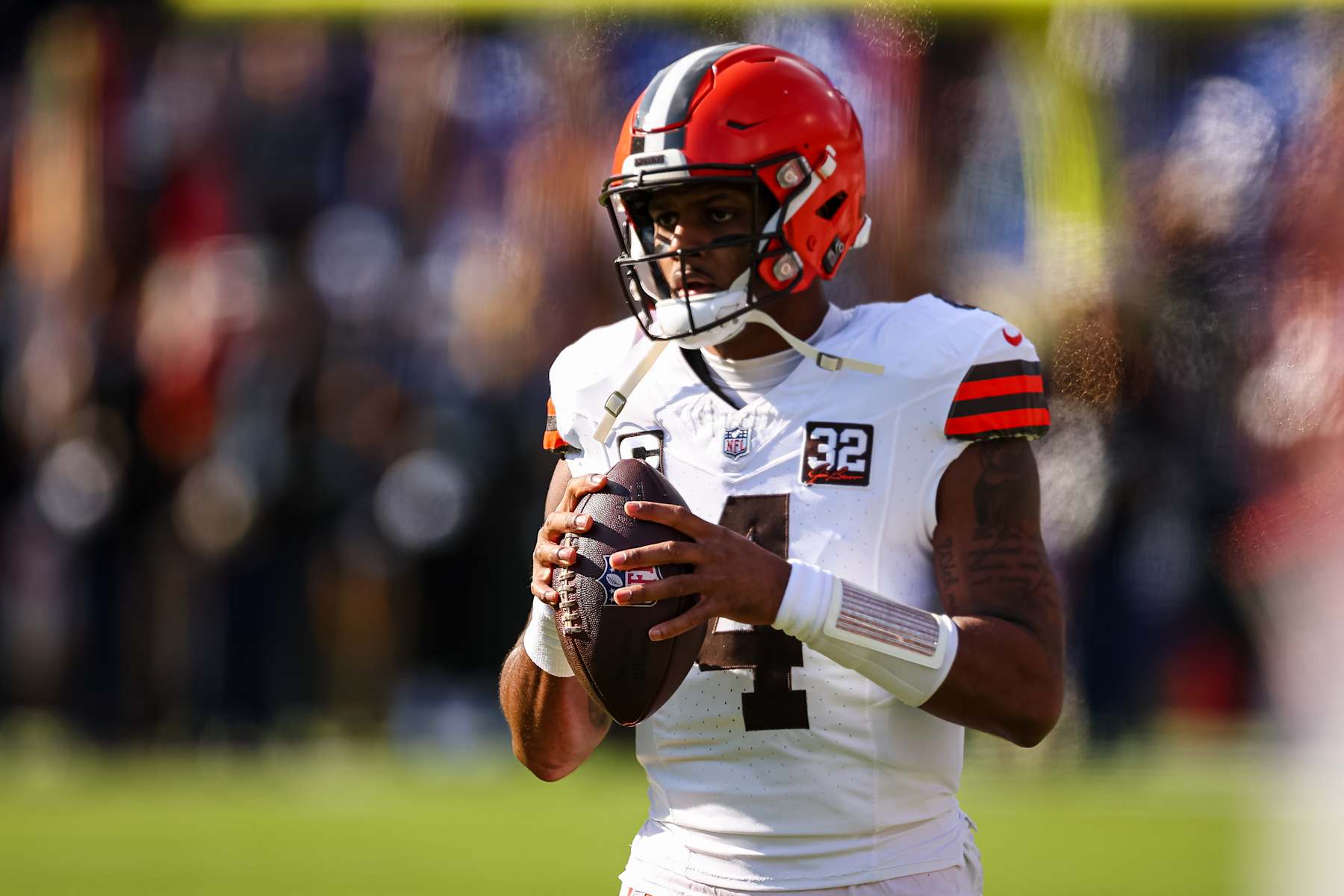As the 2024 NFL season looms, the anticipation builds for those eager to see their teams in action. Alongside the excitement, however, comes a dose of harsh reality: Some players, despite their hefty contracts, may not live up to the financial expectations set upon them. Whether it be due to declining performance, injury or a simple overestimation of their value, the following names are pocketing large sums without equivalent results on the field.
Below, we'll spotlight those who, despite their salaries, could leave organizations questioning both the short- and long-term return on their investment. Worst Investment: Deshaun Watson, Cleveland Browns (total contract value: five years, $230 million) The 10th-highest paid player in football, Deshaun Watson's tenure in Cleveland has failed to live up to expectations. With a deal that totals $46 million annually, the 28-year-old is being compensated as one of the top signal-callers in football.

However, Watson has failed to produce at any level beyond sub-standard since his arrival in Cleveland, and he could enter the fall with a short leash considering the depth chart of talent behind him should things go even further south. In two seasons with the Browns, the three-time Pro Bowler has thrown for 14 touchdown passes compared to nine interceptions. Runner-up: Daniel Jones, New York Giants (total contract value: four years, $160 million) Daniel Jones signed a lucrative extension with the New York Giants in March 2023, but questions continue to swirl about his future in the Big Apple.
While the 2019 No. 6 pick has shown flashes in his five seasons at the helm, injuries and a lack of consistent production have stopped him from cementing himself as the Giants' long-term answer under center. Heading into 2024, there may not be a more scrutinized signal-caller in the NFL than Jones.
Worst Investment: D'Andre Swift, Chicago Bears (total contract value: three years, $24 million) D'Andre Swift is being paid handsomely to complement QB Caleb Williams in the Chicago Bears' backfield. While Swift enjoyed a successful 2023 in Philadelphia, he's never played a full 17-game NFL season and his production last fall could largely be contributed to an Eagles front five widely regarded as one of the best in football. The 25-year-old eclipsed the 1,000-yard plateau in 2023 for the first time in his career, amassing 1,049 rushing yards on 229 carries (4.
5 YPC) with Philly. Swift will start as the lead back in Chicago, but it remains a question if he can replicate his success behind a weaker offensive line. Considering Chicago has both Khalil Herbert and Roschon Johnson (963 rushing yards combined in 2023) on the roster, the money tied to Swift looks like a bit of an overpay at the moment.
Runner-up: Jonathan Taylor, Indianapolis Colts (total contract value: three years, $42 million) There are zero questions to be asked regarding the fundamental talent of Jonathan Taylor. However, the 25-year-old has failed to remain on the field in each of the last two seasons and will enter 2024 with a point to prove. In what will be a campaign for Taylor to not only silence critics over whether he's worth his current contract, he'll also look to prove that his first and second seasons as a pro weren't a fluke.
After amassing over 3,000 rushing yards in his first two campaigns combined, the Wisconsin product has appeared in just 21 games the last two seasons and gone over 100 yards rushing just three times. Worst Investment: Tee Higgins, Cincinnati Bengals (total contract value: one year, $21.8 million) Set to compete on the franchise tag, allocating upward of $22 million to a wideout who remains the second-most talented pass-catcher on the roster and who has failed to eclipse 1,100 yards in a season is a hefty pill to swallow.
It remains to be seen whether Higgins' future remains in Cincinnati, but that amount of money designated to a pass-catcher not named Ja'Marr Chase is a head-scratcher, no matter how important he may be to the Bengals' offensive structure. Runner-up: Courtland Sutton, Denver Broncos (total contract value: four years, $60.8 million) Denver's de-facto No.
1 wideout over the last handful of seasons, Courtland Sutton has failed to amass over 830 yards receiving in each of the last four campaigns. While 2023 saw him reach a new career high in touchdowns (10), the 28-year-old hasn't evolved into the matchup nightmare the Broncos thought he'd become after his electric 2019 campaign (1,112 yards). However, rookie quarterback Bo Nix is expected to provide a jolt to Denver's passing attack that should assist in Sutton elevating his performance ceiling.
Worst Investment: Noah Fant, Seattle Seahawks (total contract value: two years, $21 million) The NFL's 10th-highest paid tight end, Noah Fant's contract value hasn't aligned with the production expected within the hashes. A 2019 first-round selection for the Denver Broncos, the 26-year-old failed to reach the end zone in 2023 and enters the fall with a massive spotlight on his game considering his cap hit next season ($13.5 million).
It's a long line for targets in Seattle, but more is expected from the flex weapon in Fant considering his annual earnings. Runner-up: Colby Parkinson, Los Angeles Rams (total contract value: three years, $22.5 million) Dishing out roughly $7.
5 million AAV for a primary Y-alignment tight end is beyond me. The importance of blocking tight ends and having a veteran within an offense go without saying, but there are options nearer and far cheaper than what the Rams are paying Colby Parkinson. While the 25-year-old's game will continue to evolve, using a late-round draft selection or scouring the UDFA market—which the Rams have used to their advantage on defense —may have been a wiser route.
Worst Investment: Andrew Wylie, Washington Commanders (total contract value: three years, $24 million) Last year was a mess for Andrew Wylie. Following a handful of seasons in Kansas City, the two-time Super Bowl winner followed OC Eric Bieniemy to Washington and into the right tackle spot. He proceeded to allow nine sacks in 15 starts, including 42 pressures and 27 QB hits.
Wylie will enter 2024 with a short leash under a new regime that has zero ties with his signing, and more importantly, the job of keeping QB Jayden Daniels' arm-side clean. Runner-up: Tytus Howard, Houston Texans (total contract value: three years, $56 million) The success of C.J.
Stroud masked inefficiencies up front for Houston last fall, but Tytus Howard remains a disappointing investment for the Texans. While inconsistency and injury derailed his production last fall, the 2019 first-rounder has been unable to find the form that previously showcased a high-level starter at either tackle or guard. Howard enters 2024 as one of the 15 highest-paid offensive tackles in the league with an $18.
7 million AAV. Worst Investment: Robert Hunt, Carolina Panthers (total contract value: five years, $100 million) New Panthers general manager Dan Morgan didn't pinch pennies this spring when it came to protecting Bryce Young. With the quarterback's rookie campaign spent in equal amounts flat on the turf and upright scanning defenses, Morgan paid Robert Hunt to fortify a new-look Carolina front.
However, there are questions both in the player and the money allocated for the 28-year-old's services. Only the second guard in NFL history to sign a contract amassing $100 million in total money (after Atlanta's Chris Lindstrom), the whopping $63 million in guarantees suggests that Hunt is expected to compete at an All-Pro level in the seasons to come. In four seasons, the Louisiana product has failed to make an All-Pro team or a Pro Bowl, but he has remained league average, allowing nine sacks and 80 pressures in his 61 career starts.
Runner-up: Damien Lewis, Carolina Panthers (total contract value: four years, $53 million) Upward of $53 million is a lot of cash for a player who has allowed 97 pressures and accrued 25 penalties in just four seasons. That's not to say Damien Lewis won't showcase well in Carolina, but the money tied to the former Seattle guard paints the picture of a player who is expected to produce in waves in the years to come. While the 27-year-old entered the NFL as a refined run-blocker, his highest level of success the last few seasons has come in pass protection (three sacks allowed in 2023).
For the Panthers, it's a positive sign that they hope remains a constant with upward of $153 million tied to their new faces at guard. Worst investment: Derrick Brown, Carolina Panthers (total contract value: four years, $96 million) While Derrick Brown remains one of football's elite run-defenders, nearly $100 million for a player who has provided minimal push on passing downs can be considered an overpay. Now, beauty is in the eye of the beholder in this instance and Carolina clearly opted to pay him rather than play against him, but interior push on passing downs remains king.
In what is a pass-heavy NFL, Brown ranked 28th in total pressures from the interior last fall and has failed to amass more than three sacks in either of his first four campaigns. The 26-year-old enters 2024 as the fourth-highest paid defensive tackle in football ( $24 million AAV ), alongside Jets DT Quinnen Williams who, for context, has amassed 34 sacks in the same amount of time that Brown has been active. Runner-up: Jonathan Allen, Washington Commanders (total contract value: four years, $72 million) Though Jonathan Allen has been a mainstay along the Commanders line since 2017, the play of running mate Daron Payne and the addition of 2024 second-rounder Johnny Newton has raised a few eyebrows over his future in Washington.
Though Allen has two Pro Bowl selections under his belt, his production has dipped in multiple categories over the past two seasons. With a new regime in town with zero ties to the selection or extension of the 29-year-old, Washington could both idealize the future of Payne and Newton while exploring new avenues for Allen if his play isn't up to snuff. Worst Investment: Von Miller, Buffalo Bills (total contract value: six years, $120 million) Now 35 years old, it looks as if time, and injuries, have caught up to Von Miller a bit.
While he remains one of the best to align at the edge spot in the NFL, he failed to record a sack in 2023 (first time in his career) but is set to be paid similarly to the top pass-rushers ($20 million AAV) in today's game. Injuries have hampered the eight-time Pro Bowler's ability to work back up to 100 percent health, but it comes with the wear and tear of 10-plus years in pro football. For Buffalo's perspective, paying Miller was a swing for the fences in hopes he could provide the same juice as he did for the Rams during their Super Bowl run.
The three-time first-team All-Pro remains an exception to the rule when it comes to aging out, but he may be closer to hanging up his cleats than posting another 10-plus sack season. Runner-up: Jonathan Greenard, Minnesota Vikings (total contract value: four years, $76 million) One season of immense production in Houston earned Jonathan Greenard a healthy pay day. It's the nature of the market in which teams are consistently in search for sack artists, but I'd pump the brakes on expectations.
Fourteen sacks in year four for the 27-year-old was enough to open the wallet of Vikings GM Kwesi Adofo-Mensah, but it's a heck of a bet on a player who totaled just one in his rookie season and two in 2022. Worst Investment: Jordyn Brooks, Miami Dolphins (total contract value: three years, $26.3 million) Set to start alongside David Long Jr.
within the heart of Miami's defense, Jordyn Brooks was paid handsomely to lift the performance ceiling of the unit. However, his lack of production on passing downs raises questions as to why GM Chris Grier made the 26-year-old the ninth-highest paid off-ball linebacker in the NFL. Brooks remains a dynamic and physical force in countering the run, but his lack of fluidity in space and inability to mirror RBs and TEs in man coverage could limit his overall impact in Miami.
The Texas Tech product is a tackling machine and improved in rushing the passer last fall (six sacks was a career high), but his ability to improve in coverage will tell the story on whether he's worth the value of his contract. Runner-up: Kenneth Murray, Tennessee Titans (total contract value: two years, $15.5 million) Tennessee didn't break the bank to sign Kenneth Murray, but his $7.
8 million annually ranks 15th among all NFL inside 'backers. Like Brooks, the 25-year-old is an athletic mover with the twitch and instincts to fly from sideline to sideline against the run, but his issues arise in coverage. Slated to start alongside new addition Ernest Jones IV for the Titans, Murray's knack for finding comfortability in space will raise his performance ceiling and quantify his monetary commitment.
Worst Investment: Trevon Diggs, Dallas Cowboys (total contract value: five years, $97 million) If you like corners who tout the ability to take the football away, then Trevon Diggs is your guy. However, the alarm sounds when it comes to him as a cover corner. While his instincts and awareness in space remain near the best in football at the position, the 2020 second-rounder has been one of the league's worst perimeter defenders when it comes to yards allowed in coverage.
The two-time Pro Bowler missed all but two games last year due to injury, but in 2022, he allowed 760 yards as the primary defender in coverage (sixth-most in the NFL) and in 2021, he was the only corner in football to allow over 1,000 yards in coverage. Simply put, when Diggs isn't making plays on the football, which is a majority of the time he's on the field, he's consistently been a liability in coverage for Dallas. Runner-ups: James Bradberry, Philadelphia Eagles (total contract value: three years, $38 million) and Emmanuel Forbes, Washington Commanders (four years, $15.
4 million) One of Philadelphia's top corners last fall, James Bradberry was nearly unplayable during the final third of its campaign. His postseason wasn't pretty, either, as he allowed five catches on six targets for 108 yards and a touchdown in the Eagles' wild-card loss to Tampa Bay. With an influx of young talent in the building following the selections of corners Quinyon Mitchell and Cooper DeJean in this year's draft, Bradberry's future remains as up in the air as anyone on the roster.
A move to safety this summer has showcased Philadelphia's ability to try to make it work, but Bradberry's lack of experience at the position and a moveable contract that has two years left could force GM Howie Roseman to open the phone lines. For Emmanuel Forbes, year two in Washington could be a make-or-break campaign. Following an abysmal rookie year in which coaching did the 23-year-old—a Cover 3 corner in college—no favors in aligning in man early in 2023, he could play himself out of a roster spot before his career really started in Washington.
The current regime has zero ties to Forbes, and he is the Commanders' third and last perimeter corner on the depth chart. If steps aren't taken, snaps will be hard to find. Worst Investment: Justin Reid, Kansas City Chiefs (total contract value: three years, $31.
5 million) Justin Reid is a serviceable defender in Kansas City. He can set up shop at different depths and alignments, make plays against the run and pass, and he has shown the ability to cut his teeth on special teams. However, there's nothing currently in the 27-year-old's game that can be qualified as "elite.
" While Chiefs GM Brett Veach is one of the NFL's brightest and intuitive decision-makers when it comes to allocating funds, paying Reid roughly $10.5 million per year (13th-highest AAV among NFL safeties) seems a bit of stretch for what he offers on a week-to-week basis. Runner-up: Xavier McKinney, Green Bay Packers (total contract value: four years, $67 million) The prized free agent of Green Bay's 2024 offseason, Xavier McKinney enters the fall with an immense amount of expectations.
The 2020 second-round selection for the Giants has failed to earn All-Pro or Pro Bowl accolades, but Green Bay made him the fourth-highest paid safety ( $16.8 million AAV ) in the NFL. McKinney's instincts (nine interceptions in four years) should showcase well in Green Bay, but his ability to remain healthy (played just six games in his rookie season and nine in 2022) will hold the key to him proving why GM Brian Gutekunst is paying him so handsomely.
All cap figures via Spotrac ..



















